Richtofen's wife #ghoultofenadult | college student/worker (STEM)
Don't wanna be here? Send us removal request.
Text
Proof of Behavior
Someone decided it would be really funny if, after I closed down all anonymous ways to contact me, they sent me an email with a message that contained my son's name, which was not available on any of my non-personal accounts.
So if this is what I have to do to protect my son then here you go. I guess I shouldn't be surprised considering @jamieaiken919 has a history of not understanding boundaries with minors.
I'll warn you, when I went back through to grab screenshots of everything to back my previous claims I found a lot of extremely concerning material I didn't even know existed when I made my first document.
TW: sexualization of minors, sexual content, abusive language
Considering the material concerning minors, if you read this and agree that this pattern is concerning for our community, I do ask that you consider sharing so this reaches beyond my following and protects further young people from being affected.
43 notes
·
View notes
Note
How do we draw things in general, Professor Ghoul??🤨
How to Draw Things (In General)
Generally speaking, to draw something, you just observe it and do your best with whatever medium you want to use to translate that thing into 2D. That sounds simple, but of course we all know it's a lot more complicated than that if you want your 2D translation to be understandable by viewers so let's break it down further.
Training the "Artistic Eye":
Becoming an artist doesn't actually start with drawing, but with observing. When observing a subject you want to focus on:
Overall shape or outline
Inner shapes that make up the whole
Light and shadows
Textures
Anchor points (for perspective and size comparison)
Again, that sounds simple, but if you'd tried it before you'll know it's not as easy as it seems it should be. The moment you look away from your subject to translate into 2D things often get muddled. If only we could have an accurate mental picture to reference while drawing so we didn't have to look away from our drawing, right?
That's where the "Artistic Eye" comes in. The more you look at things, really studying them with the intention to render them, the better you'll be able to hold that mental image in your head to reference while you're drawing.
Practicing Drawing While Activating Your Artistic Eye:
Have you seen those art exercises where the teacher places some random objects or fruit on a table under a spotlight and tells the students to draw them? It may sound boring, but it's crucial to building up to drawing more complicated subjects (like humans) that are composed of multiple shapes.
Start off with painfully simple shapes and build up to more complicated designs and lighting. For example:

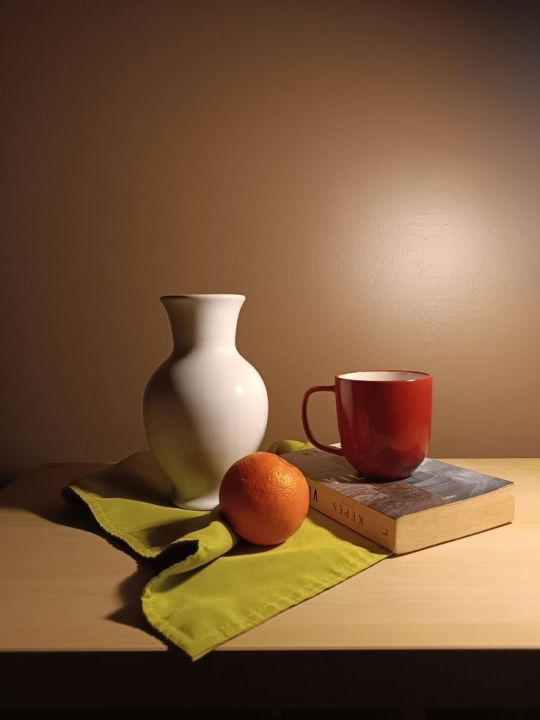


Remember those specific traits to focus on with your artistic eye? Let's break down one of these images with some key observations to help you get started:
The Greyscale Shapes Image: The focus point of the composition is the ball taking front and center. Since that's our anchor point we want to think of everything around the ball in relation to it. The square is approximately the same shape as the ball, but just a bit smaller because of perspective. The cylinder and cone appear to be the same height and both are the about two balls tall. Both the bottom of the cylinder and the bottom right corner of the square line up with the middle of the circle.
Try doing this mental exercise with the more complicated images: Can you figure out how many oranges tall the vase is in the second example? Can you identify the shapes that make up the planes of the skull in the third example using how the light and shadows bounce off it's uneven form? With the fourth example, pay attention to the overstated geometric angles of the face and think about how seeing the face this way might help with drawing a naturally curved face.
But Professor Ghoul, This is All Realism! You draw CARTOONS!!!
Yes, indeed. Once you grasp how to draw realism you can stylize your art through "abstraction." Cartoons (anime, comic book art, rubber hose) are just abstract art translations of realism where you play with the proportions, simplify shapes and lighting, and create a representation of a real thing. This is where stylization comes in and for more on that see my "Finding Your Style" Guide.
FINE! But What If I Want to Draw From My Imagination?
This helps with that too! When you look at things with your artistic eye you're adding them to a mental catalog that, after you build up the catalog enough, you can start using to imagine your own references. If you want to to draw an angel warrior, spend time analyzing bird wings, humans, armor and weapons and you'll eventually be able to mentally piece them together in a multitude of ways to draw in your style.
Last Notes:
I found the book "Drawing on the Right Side of the Brain" by Betty Edwards extremely helpful when I was learning to train my artistic eye. While the whole "left side/right side" brain theory has been updated in recent years the concepts and exercises in that book are still sound training for how to view things to translate artistically.
I hope this helps! Feel free to ask more questions if you need me to break down any of these concepts further or if there's a specific thing you are looking to learn to draw!
6 notes
·
View notes
Text
Finding Your Style
or what to do when you reach a point where you don't love your art
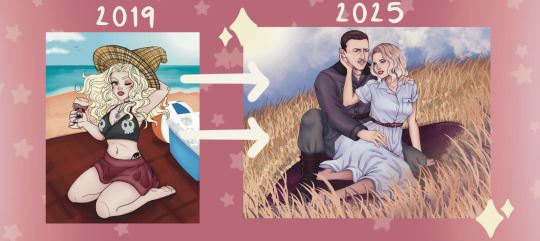
TL;DR: Study the basics, study different art styles, experiment with technique/mediums, don't prioritize consistency over growth!
How One Creates a Unique Style
Whether we realize it or not the style we draw in is usually a combination of styles from artists we admire. There can be a lot of pressure online to be Unique and a lot of misunderstanding about what counts as plagiarism. The truth is, everyone’s style was influenced by other artist(s) and accepting that allows you to be active in your style's development and mix your inspirations together to create Your Unique Style.
When One Used to Like Their Art, but Now... Not So Much
This usually happens when you reach a "Growth Plateau." Especially if you do art professionally there's a lot of pressure to be consistent which can prevent you from trying new things or updating your style. Boxing yourself in and not allowing yourself to keep developing new art techniques can actually lead to art block or feeling like art has become a chore.
Additionally, our "artistic eye" and our art abilities do not always grow at the same pace. This means you may look at your art and see errors or not like the style, but don't have the knowledge to change it.
Let's Get Started!
Both creative issues can be fixed the same way!
Go Back To The Basics:
While most basic art exercises can be a bit boring, it's really important to have a good foundation for your art to grow from. Even if your art style is rubber hose cartoons, don't ignore studying realism or the basics! Knowing how something is rendered realistically helps make sure your cartoon art style doesn't enter Uncanny Valley territory. And if you already have that foundation, it's still a good idea to refresh and see if there's any room for improvement.
For anatomy try gestures, figure drawing, or body part studies - there's a lot of great YouTube videos. You can also do line and shading exercises, studying different light types and sources - I usually use Pinterest tutorials to practice with.
Do “Recreation Exercises”:
Find a style you like and try to recreate it as accurately as possible. These practices aren’t meant to be shared or claimed as one’s own - it's for private learning purposes only. While there may be some controversy about this learning method on the internet, this is a very normal and common exercise done in art school. Usually it's done with art by the "Old Masters" but if you want to practice something more modern guilt-free you can find an artist that posts tutorials on how to draw in their style.
Afterwards, try mixing and matching what you practiced recreating into a new style. For example, the nose from one artist, the eyes or proportions from another. The more you make each element of your art inspired by a different artist the less derivative of one artist's work it will be. Keep mixing it up, adjusting to your liking, until eventually you have your own Unique Style that you're comfortable with.
If you already have a style and you just want to grow it further, doing this exercise should allow you to see what about your own style you're unhappy with and adjust.
Try Different Techniques or Mediums:
If you're a predominantly digital artist this can either mean breaking out the sketchbook with some good ole graphite, finding a painting tutorial, or even just testing out different brush sets. Basically, whatever it is your comfortable doing while creating art do something different. Instead of clean lines, try messy sketch lines. Instead of cell shading, try soft shading or crosshatching. Play with proportions! Anime, realism, cartoons, and comic book styles all teach different proportions for bodies and faces so have fun changing up whatever proportions you're used to using. Get out of your comfort zone and try new stuff!
The main way to develop your art style or get over a growth plateau is to take risks and adjust your style until you find something satisfying.
If you do art professionally or publicly it can be easy to get stuck in doing art the same way every time, prioritizing consistency over growth. Even if you don't change how you do your commissions because you're worried about it affecting your business you can still explore your personal art. Even if you have a queue of commissions it's very important in preventing art block to do art for yourself as well, both for your artistic growth and mental state.
15 notes
·
View notes
Text
Tackling Art Block
Recently someone on Twitter asked for advice and in my usual verbose fashion I infodumped. I tried to compile everything I learned in art school and working with professional comic book artists that have helped me throughout the years so I figured I'd post it here too in case it helps anyone.
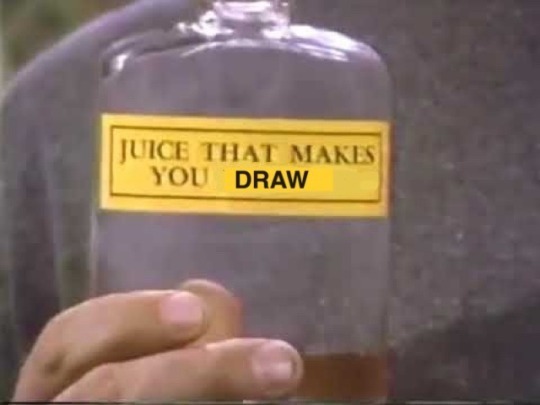
TL;DR:
Take an Intentional Break with a set return time
Seek out new inspiration to recharge
Take care of outside disrupting factors and yourself
Seek support from the creative community or a person you trust
Ease back into creating by making things for yourself before you return
Identifying the Cause:
Typically, art block happens because of lack of inspiration or burn out Burn out is common for artists who post publicly or do art professionally because of the pressure to create to remain relevant to their followers and keep up with workloads deadlines.
Prevention:
As soon as you start getting the inkling of a feeling that making art is a chore it's probably a sign that Art Block is trying to wiggle it's way into your head. If you can catch it early and take care of it then it usually requires less time to resolve.
How to Resolve:
Take a Break!
Take a break from creating with the intention to recharge your inspiration. It doesn't mean art block wins just because you aren't creating for a little bit, but it's important that you take this break with the understanding that you will take in inspiration and you will be creating again. If necessary, communicate to your followers or commissioners that you're taking time off - they'll probably be understanding and supportive!
Set a Return Time:
Having a set time to return to creating art helps you relax during your break because you know that this is not forever. Try not to treat this as another deadline, but as an assurance that you will enjoy creating again. Whatever amount of breaktime you decide is right for you, let yourself relax and not think about creating. Your total focus should be on recharging and taking in inspiration.
If you catch it early you may only need a couple days to recharge, but it you're experiencing more intense Art Block then I suggest you give yourself at least a week. Most things in life can handle being put off for a single week. You really need to mentally allow yourself to not think about any art related pressures or guilt for a decent block of time. Usually, it's hard to do this the first couple days of a set break time so make sure to plan enough time that you get a couple days of full mental freedom.
Remember you are doing this for your art and for the people who consume your art. You aren't letting anyone down: you're working on yourself so you can be the best creator you can be.
Finding Inspiration:
During your break, consume art and media. Look at art by your favorite artists or discover new artists. You can also watch animated/art based media, read comics or play games to passively expose yourself to art. I find scrolling through Pinterest art tutorials helpful because I'll often find something new I want to try out. The whole point is to spark that Desire to Create again.
Address Non-Creative Disruption Factors:
Its also a good time to sort out any life stuff that may be stressing you out. Clean that doom corner, tackle the dishes, make that appointment you've been pushing off, etc. It's also important to practice some self care. Take care of yourself and anything else that could prevent you from focusing on enjoying time spend on art.
Ease Back Into Creating:
In the last few days of your break, ease back into creating by making art that is Only For Yourself. Hopefully by then you've gotten inspiration from the art you've been consuming and now is the time to use it to create something that isn't attached to any of the pressures of being a public artist. Allow yourself to make "Bad Art" or silly doodles. Your enjoyment is all that matters. Sometimes trying different mediums can help separate you from any pressure to create "Good Art" because there shouldn't be an expectation for you to be a master with a medium you've never used before.
Reach Out to Others:
If you are struggling to tackle your art block on your own then you should try opening up to some of your fellow artists for support. You don't have to go through this alone, we all have had issues with our creative process before and most artists are very community oriented, willing to encourage and support their peers. And yes, no matter your artistic level or style, we are all creative peers. IMO any artist who's ego is so big that they don't treat you as a creative peer honestly isn't worth your time.
If you aren't involved socially with any other artists you could try respectfully reaching out to an artist that inspires you for their methods or stories about dealing with art block. If they have the time an energy they'll probably be happy to help. Let them know how much they inspire you, that you're struggling right now and how it would be helpful to hear their personal stories if they don't mind sharing. You might even make a new friend!
If engaging with the art community is still too daunting, open up to a friend or family member. When asking people to help you make sure to get consent to vent and let them know what you need in return: empathy, encouragement, or problem solving/advice.
If somehow you really don't have anyone to talk to about your art then you can always self-therapy with a journal. Let all your fears and doubts out, every negative thing that pesky inner voice might whisper in your brain, get it all out of your system by writing it down. It may seem counterintuitive to focus on the negative, but acknowledging them allows you to address them. Once all the negativity is put into words address each point you brought up: encourage yourself, remind yourself that art, like all things in life, is a journey and you won't be in this stage forever, that you are a Real Artist no matter what level you are at or if you haven't created anything for a while.
Writer Block Too?!
Yes! These steps work for any type of creative process. Just change the kind of inspiration you are taking in during your recharge. If you're a writer, read books, fanfiction, or blogs. If you are a cosplay creator, look at other peoples' cosplays, new sewing techniques, fashions, and fabric types/patterns.
Last Notes:
If you create you are a Creator. There's no set level of success attached. You belong in creative communities, to grow with others, provide and receive encouragement, and share your art and ideas. You aren't alone. Art Block can be resolved. In some cases, handling art block successfully might even help you develop your art further. You can push through it.
・┆✦ʚ♡ɞ✦ ┆・
7 notes
·
View notes
Text
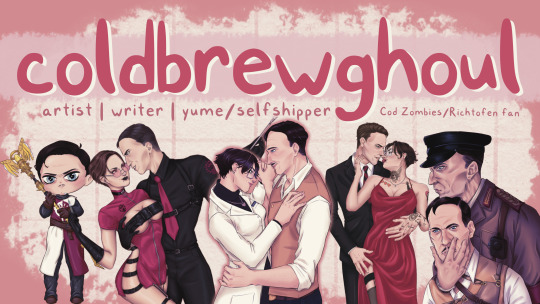
ghoul / briar they/them | intersex/trans | demi/ace/bi | adult | math/physics major
DNI: basic criteria
Twitter | Strawpage

f/o: Edward Richtofen (primis, ultimis, director, great war versions) Supportively Sharing
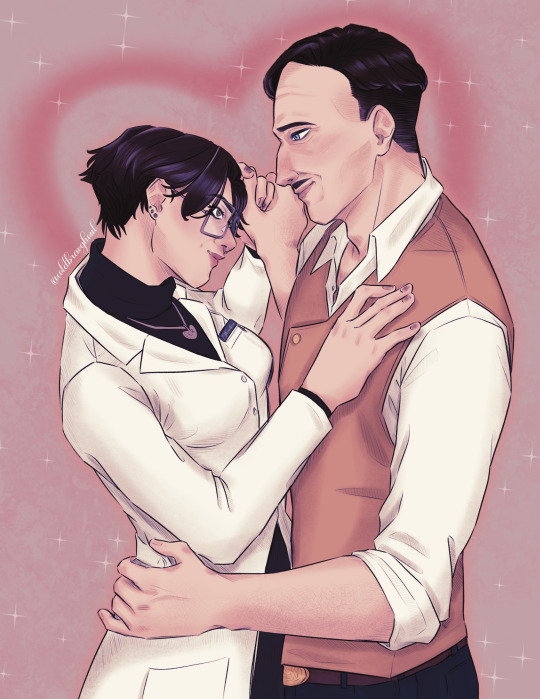
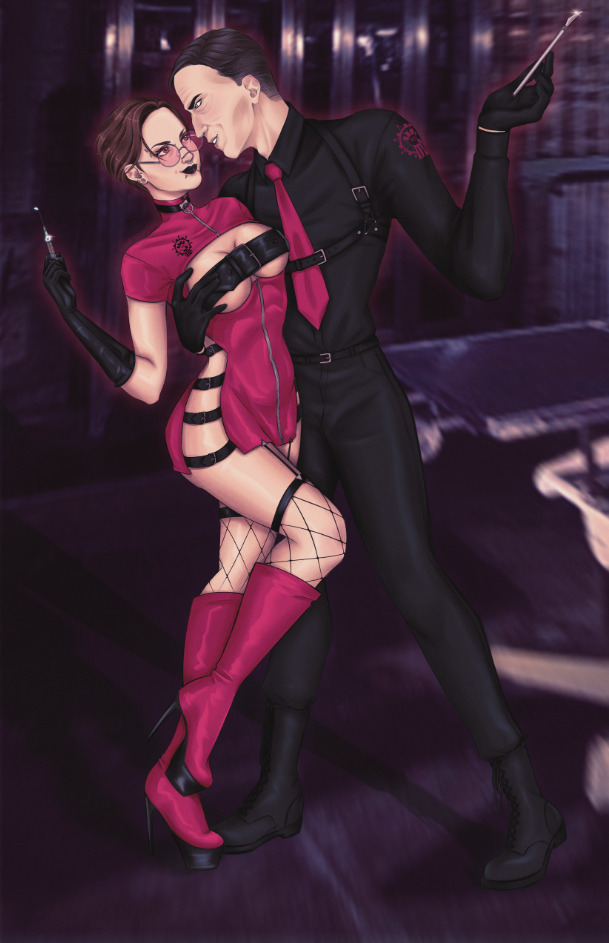


#coldbrewghoul#coldbrewghoul comms#coldbrewghoul art#coldbrewghoul fic#ghoultofen#coldbrewghoul codz
13 notes
·
View notes